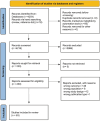Sex Differences in Bleeding Risk Associated With Antithrombotic Therapy Following Percutaneous Coronary Intervention
- PMID: 38606417
- PMCID: PMC11004037
- DOI: 10.1253/circrep.CR-24-0015
Sex Differences in Bleeding Risk Associated With Antithrombotic Therapy Following Percutaneous Coronary Intervention
Abstract
Background: Antithrombotic therapy is crucial for secondary prevention of cardiovascular disease (CVD), but women with CVD may face increased bleeding complications post-percutaneous coronary intervention (PCI) under antithrombotic therapy. However, women are often underrepresented in clinical trials in this field, so evidence for sex-specific recommendations is lacking. Methods and Results: A search on PubMed was conducted for English-language articles addressing bleeding complications and antithrombotic therapy in women. Despite women potentially showing higher baseline platelet responsiveness than men, the clinical implications remain unclear. Concerning antiplatelet therapy post-PCI, although women have an elevated bleeding risk in the acute phase, no sex differences were observed in the chronic phase. However, women require specific considerations for factors such as age, renal function, and weight when determining the dose and duration of antiplatelet therapy. Regarding anticoagulation post-PCI, direct oral anticoagulants may pose a lower bleeding risk in women compared with warfarin. Concerning triple antithrombotic therapy (TAT) post-PCI for patients with atrial fibrillation, there is a lack of evidence on whether sex differences should be considered in the duration and regimen of TAT. Conclusions: Recent findings on sex differences in post-PCI bleeding complications did not provide enough evidence to recommend specific therapies for women. Further studies are needed to address this gap and recommend optimal antithrombotic therapy post-PCI for women.
Keywords: Anticoagulants; Antiplatelet therapy; Cardiovascular disease; Percutaneous coronary intervention (PCI); Sex.
Copyright © 2024, THE JAPANESE CIRCULATION SOCIETY.
Conflict of interest statement
Y.M.N. reports a study grant from Bayer, outside of this study. All other authors have nothing to disclose.
Figures


Similar articles
-
Risk of Stroke vs. Intracerebral Hemorrhage in Patients with Non-Valvular Atrial Fibrillation Undergoing Percutaneous Coronary Intervention: A Systematic Review and Meta-Analysis of Randomized Controlled Trials Comparing Dual vs. Triple Antithrombotic Therapy.J Stroke Cerebrovasc Dis. 2021 Apr;30(4):105654. doi: 10.1016/j.jstrokecerebrovasdis.2021.105654. Epub 2021 Feb 10. J Stroke Cerebrovasc Dis. 2021. PMID: 33578352
-
Antithrombotic therapies in Canadian atrial fibrillation patients with concomitant coronary artery disease: Insights from the CONNECT AF + PCI-II program.J Cardiol. 2023 Aug;82(2):153-161. doi: 10.1016/j.jjcc.2023.03.004. Epub 2023 Mar 16. J Cardiol. 2023. PMID: 36931433
-
An analysis of antithrombotic therapy in elderly patients with atrial fibrillation undergoing percutaneous coronary interventions.Clin Exp Pharmacol Physiol. 2023 Jul;50(7):583-593. doi: 10.1111/1440-1681.13775. Epub 2023 Apr 27. Clin Exp Pharmacol Physiol. 2023. PMID: 37057840
-
Antithrombotic therapy in atrial fibrillation patients with coronary artery disease: shifting paradigm to a "less is more" concept regimen.J Cardiol. 2020 Jul;76(1):35-43. doi: 10.1016/j.jjcc.2020.03.001. Epub 2020 May 8. J Cardiol. 2020. PMID: 32389534 Review.
-
Duration of Triple Antithrombotic Therapy and Outcomes Among Patients Undergoing Percutaneous Coronary Intervention.JACC Cardiovasc Interv. 2016 Jul 25;9(14):1473-83. doi: 10.1016/j.jcin.2016.04.027. JACC Cardiovasc Interv. 2016. PMID: 27478115
References
-
- Bueno H, Byrne RA, Collet JP, Costa F, Jeppsson A, Kastrati A, et al.. 2017 ESC focused update on dual antiplatelet therapy in coronary artery disease developed in collaboration with EACTS. Eur Heart J 2018; 39: 213–260, doi:10.1093/eurheartj/ehx419. - PubMed
-
- Levine GN, Bates ER, Bittl JA, Brindis RG, Fihn SD, Fleisher LA, et al.. 2016 ACC/AHA Guideline Focused Update on duration of dual antiplatelet therapy in patients with coronary artery disease. J Am Coll Cardiol 2016; 68: 1082–1115, doi:10.1016/j.jacc.2016.03.513. - PubMed
-
- Nakamura M, Kimura K, Kimura T, Ishihara M, Otsuka F, Kozuma K, et al.. JCS 2020 Guideline focused update on antithrombotic therapy in patients with coronary artery disease. Circ J 2020; 84: 831–865, doi:10.1253/circj.CJ-19-1109. - PubMed
-
- Melloni C, Berger JS, Wang TY, Gunes F, Stebbins A, Pieper KS, et al.. Representation of women in randomized clinical trials of cardiovascular disease prevention. Circ Cardiovasc Qual Outcomes 2010; 3: 135–142, doi:10.1161/CIRCOUTCOMES.110.868307. - PubMed
-
- Ding EL.. Sex differences in perceived risks, distrust, and willingness to participate in clinical trials: A randomized study of cardiovascular prevention trials. Arch Intern Med 2007; 167: 905, doi:10.1001/archinte.167.9.905. - PubMed
Publication types
LinkOut - more resources
Full Text Sources
Miscellaneous

